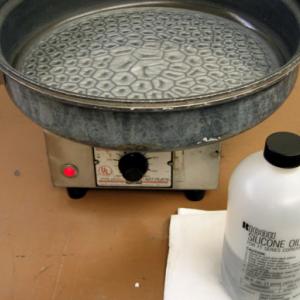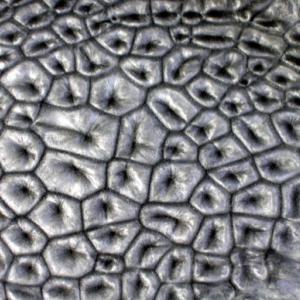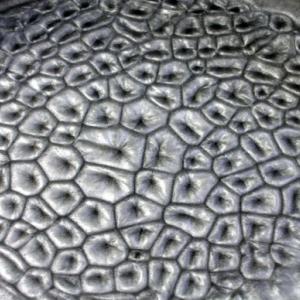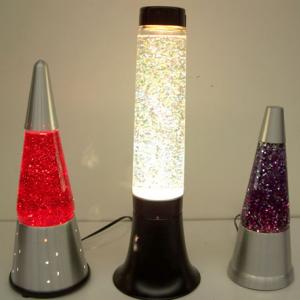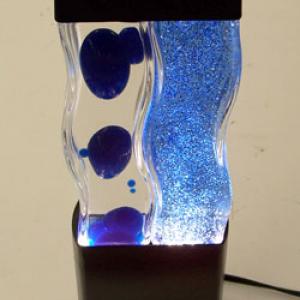College of Liberal Arts & Sciences
8B10.40 - Convection Cells or Rayleigh-Benard Cell
See also 2B40.55 in Heat and Fluids, 2B40.55 in Astronomy, and 4B20.50 in Heat and Fluids.
Place the frying pan on the hot plate. Turn the hot plate to between 350 and 400 on the temperature dial. Add the full pint of oil/aluminum powder mixture.
CAUTION: The oil does not have to be very hot to give good convection cells. If the temperature is too high the oil may ignite.
Once the cells have formed they will appear very stable. You can use a spoon to disturb the cell structure and watch its reformation.
This demo will show mostly 5 fold symmetry.
- Jay Pasachoff, "This Month's Cover...", TPT, Vol. 55, #3, Mar. 2017, p. 129.
- Todd R. Leif, "Lava Lamp", TPT, Vol. 46, #4, April 2008, p. 219.
- Cover Picture, TPT, Vol. 35, #7, Oct. 1997.
- Stephen J. Van Hook and Michael F. Schatz, "Simple Demonstrations of Pattern Formation", TPT, Vol. 35, #7, Oct. 1997, p. 391.
- John Wettlaufer, "The Universe in a Cup of Coffee", Physics Today, Vol. 64, #5, May 2011, p. 66.
- A. V. Getling and O. Brausch, "Cellular Flow Patterns and their Evolutionary Scenarios in Three-Dimensional Rayleigh-Benard Convection", The American Physical Society, Physical Review E 67, 046313-1, 2003.
- Jearl Walker, "2.89, Tia Maria Worm-Like Patterns", The Flying Circus of Physics Ed. 2, p. 120.
- Jearl Walker, "2.90, Patterns in Hot Coffee and Other Fluids", The Flying Circus of Physics Ed. 2, p. 120.
- Peacock, Rayleigh-Benard cells, E-mail, 2005.
Disclaimer: These demonstrations are provided only for illustrative use by persons affiliated with The University of Iowa and only under the direction of a trained instructor or physicist. The University of Iowa is not responsible for demonstrations performed by those using their own equipment or who choose to use this reference material for their own purpose. The demonstrations included here are within the public domain and can be found in materials contained in libraries, bookstores, and through electronic sources. Performing all or any portion of any of these demonstrations, with or without revisions not depicted here entails inherent risks. These risks include, without limitation, bodily injury (and possibly death), including risks to health that may be temporary or permanent and that may exacerbate a pre-existing medical condition; and property loss or damage. Anyone performing any part of these demonstrations, even with revisions, knowingly and voluntarily assumes all risks associated with them.
